At Koreatown’s latest gastropub, go for the homey pan-fried jeon
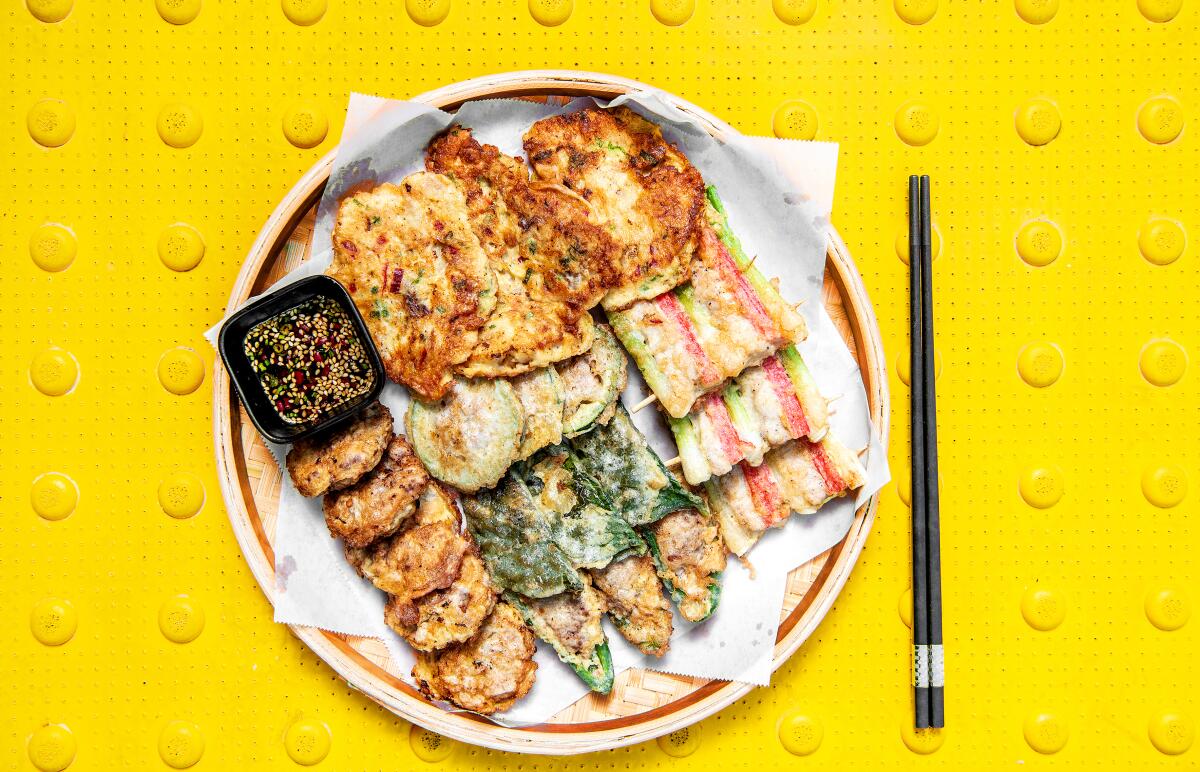
- Share via
The shapes of HanEuem’s modeum jeon — a platter of various meat, seafood and vegetable flatcakes — are soothing and striking in their unevenness: rough circles, tapering oblongs and wobbly rectangles, browned like diner omelets but with the occasional streak of yolky yellow.
These aren’t hubcap-size pancakes in the style of haemul pajeon, the discs thick with seafood and scallions formed as wide as the sizzling plates on which they’re often served. These eggy, pan-fried jeon resemble fritters as much as griddle cakes. They’ve been carefully arrayed in a woven wooden basket, overlapping so tightly that at first glance they can look like one bronzed, rippling mass.
But their individual characteristics reveal themselves once the eating begins. Start with gochujeon, halved jalapeños stuffed with small mounds of finely ground beef mixed with tofu and lightly battered. A terrific chef-y variation filled with Tennessee-style sock sausage (so named because the mixture ages briefly in muslin) is a perennial on the menu at Majordomo in Chinatown. This one hews more closely to its home-kitchen origins, satisfying in the way the pepper’s snap yields to the soft filling and in the direct, elemental flavors.
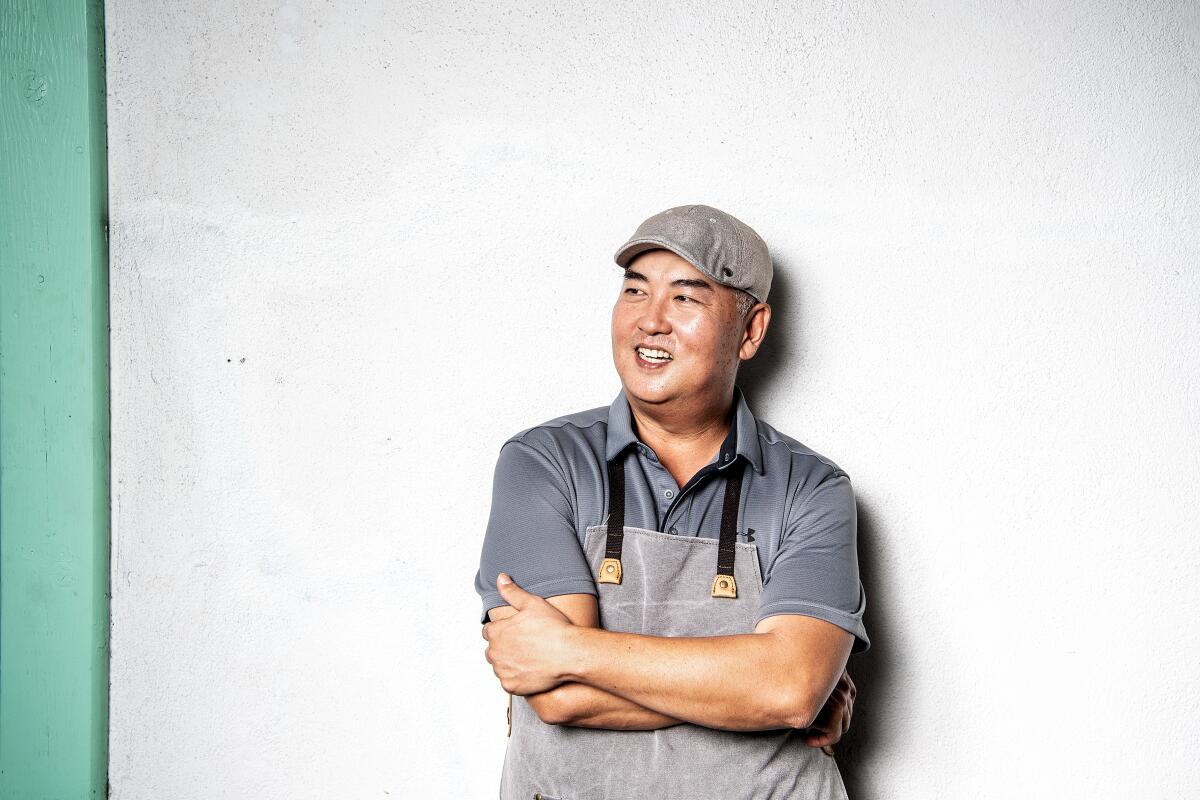
There is a mild pollock variation with scribbled-looking edges and smaller orbs in which the ground beef-tofu stuffing has been reconfigured into patties. Toothpicks bind the most intricate jeon: layers of crab, scallions and minced mushroom stacked in such exacting tiers that they resemble slices of terrine. Swish forkfuls through the soy-vinegar dipping sauce spiked with chili flakes and sesame seeds.
“This is the kind of platter that families in Korea prepare for a big event, like a birthday party for someone turning 70,” says chef and owner Wonsuk “John” Kang. He also mentions that the preparation is painstaking and that he feels bad when orders run out for the day and customers complain. I probably won’t help things by saying that the modeum jeon is HanEuem’s must-try dish.
Kang opened the restaurant in May in the space formerly occupied by Tengoku ramen bar. It huddles among the hair and nail salons, the phone and vape shops and the coffee and juice bars that line the two-story strip mall in Koreatown near Western Avenue and West 6th Street. Look for the tent sheltering four tables outside the restaurant’s entrance.
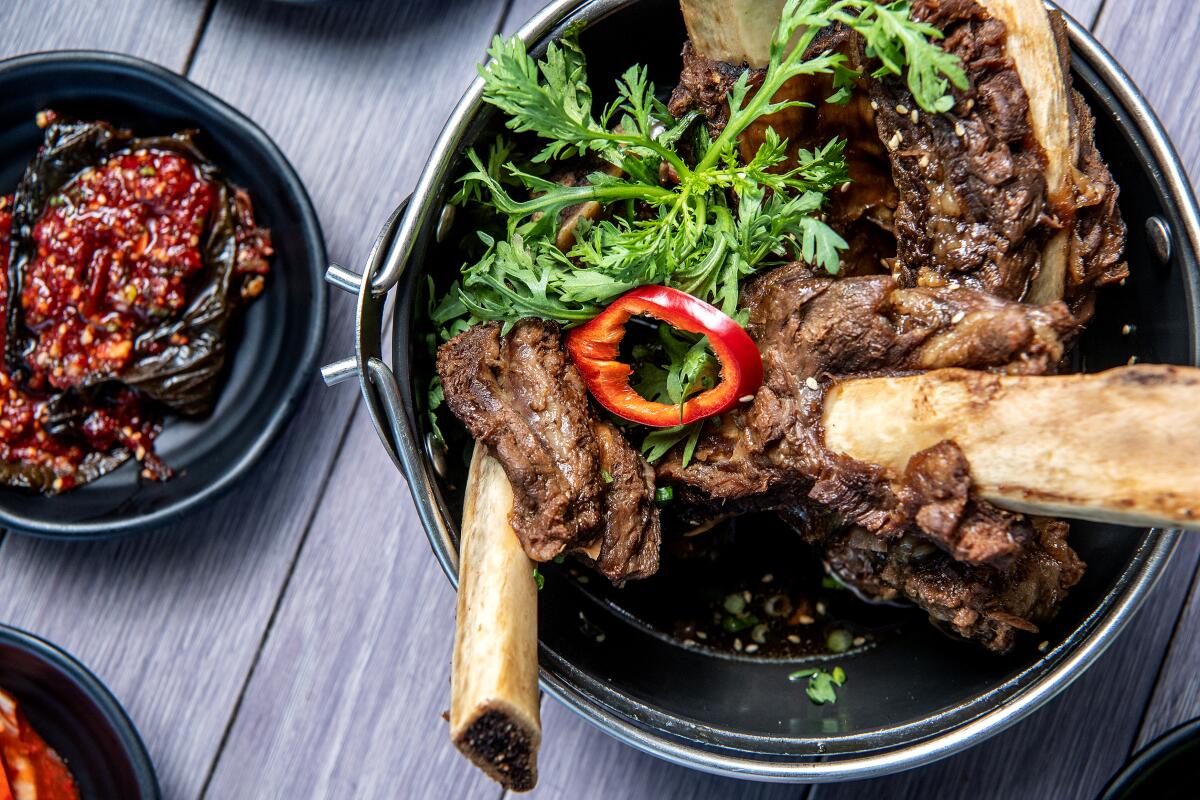
A neon sign above the door elaborates the name: Chef Kang’s HanEueum Korean Cuisine. If you’ve dined regularly in Koreatown over the last several years, you may have seen the “Chef Kang” moniker elsewhere. For nearly two decades, Kang worked as a mortgage broker. He never loved it; he was an accomplished home cook, and finally his wife nudged him to try the food business. He began with a food truck and catering gigs, but in a year he opened his first restaurant, Chef Kang Food Rehab. The menu was an untamed beast: kimchi stew, jambalaya, Polish sausage dogs topped with the works (including guac and sausage), nachos with a burger as a teetering crown.
A Korean taco joint followed, and then Rehab itself re-formed into Chef Kang’s Sul Box, a bar-food concept that simplifies the nachos, features more stews and spotlights chicken wings to pair with beer and soju.
HanEuem is Kang’s endeavor to brush aside the grab-bag fusion notions and concentrate on Korean flavors. The name, pronounced Hahn-OOM, has several meanings for him but, primarily, he translates it as “the food of Korea. (The “Euem” is a shortened version of the Korean word for food, which can be transliterated as “eumsig.”)
This menu is daunting in its own way. A Korean friend who joined me at a meal pointed out that the restaurant covers several Korean dining genres at once: drinking food, meaty specialties like galbi and bulgogi, and more homestyle dishes, including stews, soups and the combination jeon platter.
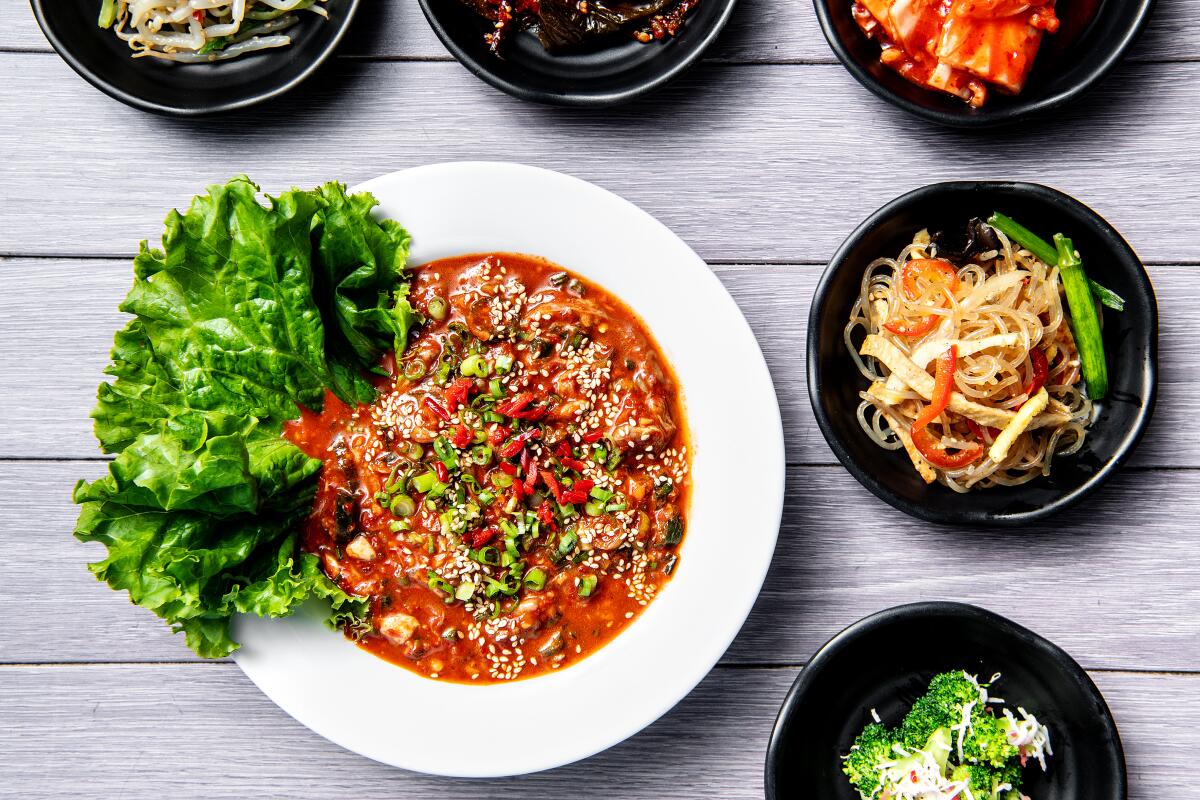
The portions are hulking, intentionally sized to share, so family-style feasting is the natural order of things. Alongside glasses of plummy sujo or bottles of Hite (or Earl Grey iced milk tea), there are shucked oysters submerged in a dense, ruddy pool of soy sauce, oyster sauce, garlic, green onions and sesame oil. The understated bit of sweetness? It comes from Sprite. Try a spicy variation of ganjang gejang, a marinated raw crab specialty, that breathes chile and garlic. A version of the classic soy sauce marinade (like the one Soban employs for its defining crab dish a mile away) is used here for raw shrimp.
I return most ardently to the stews at HanEuem. Dakdoritang, chicken and potato stew, gives off a gentle shimmer of heat despite its crimson broth. Kimchi stew with pork belly and triangles of tofu gently simmers over a burner on the table. The cloudy stock in the hot pot of mushrooms cooks down and feels like sipping a tonic.
Stews … and pancakes. The kitchen turns out a respectable haemul pajeon, appealingly midweight in texture and crisp around the circumference. Ground pork and scallions lace nokdu bindaetteok, a comforting street market snack made from ground mung beans.
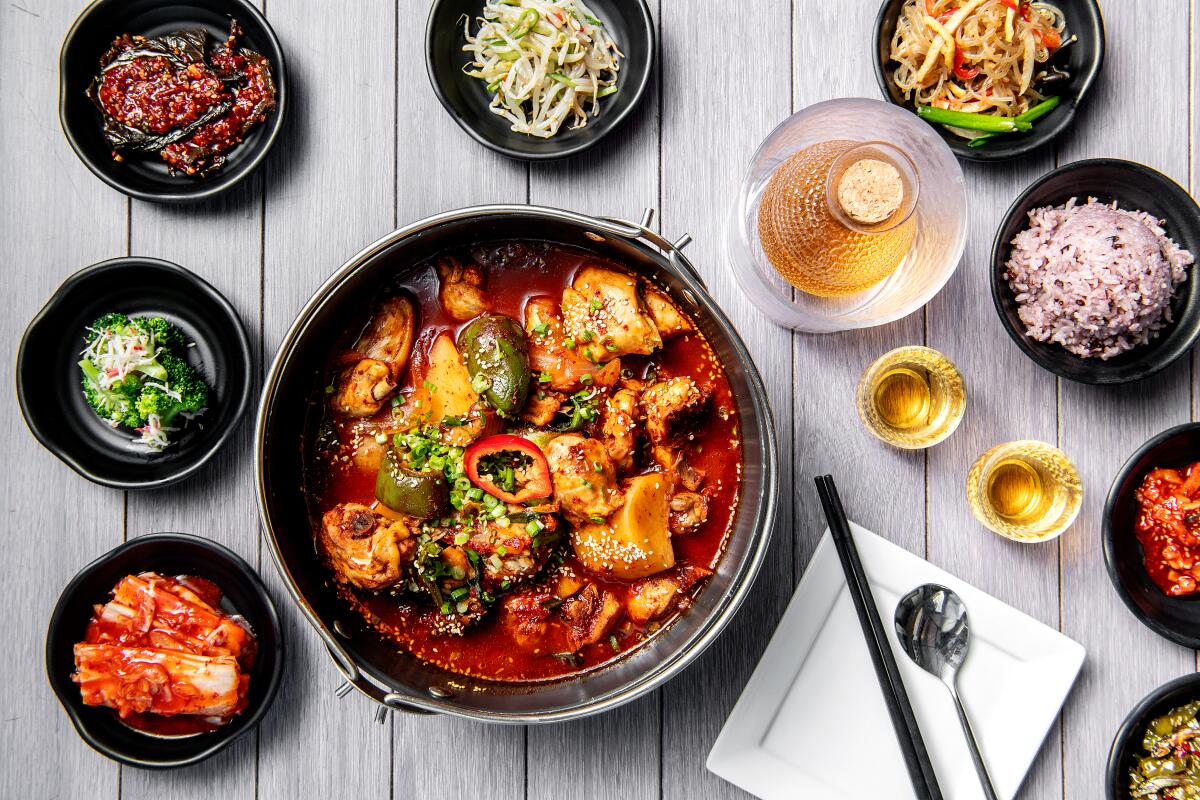
And I wouldn’t be the happiest customer, either, if I showed up and learned that the restaurant had exhausted the day’s allotment of modeum jeon. Their delicacy improved with each meal — less greasy, more evenly fried and precisely seasoned. More than a dozen of them come with an order, and they are best consumed as quickly as possible. Which is the most persuasive reason of all to show up at HanEuem with a group.
HanEuem
539 S. Western Ave., Los Angeles, (213) 388-8988, facebook.com/Haneuem
Prices: $14-$39, with most dishes sized to share.
Details: Open daily, lunch 11 a.m.-3 p.m. and dinner 5-10 p.m. Soju and beer. Credit cards accepted. Street parking.
More to Read
Eat your way across L.A.
Get our weekly Tasting Notes newsletter for reviews, news and more.
You may occasionally receive promotional content from the Los Angeles Times.










